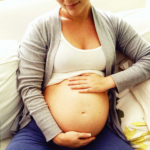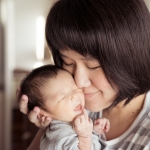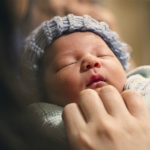Despite the use of the newer “atypical” antipsychotic agents to treat a spectrum of psychiatric disorders, including schizophrenia, bipolar disorder, major depression, PTSD and other anxiety disorders, three is relatively little data on the reproductive safety of these newer atypical agents.
In a recent prospective observational study, the authors assessed pregnancy outcomes in three groups of women recruited from the consultation service of the Institute for Clinical Teratology and Drug Risk Assessment in Pregnancy in Berlin:
Group 1: 561 women treated with atypical (or second-generation) antipsychotic agents (SGAs)
Group 2: 284 women treated with first-generation antipsychotic agents (FGAs)
Group 3: A control group of 1122 women treated drugs known as not harmful to the fetus.
Pregnant women were enrolled at any point between conception and delivery and were considered eligible if they were exposed to at least one first- or second-generation antipsychotic medication, if there were no abnormal prenatal findings, and if the outcome of the pregnancy was not known. Women with exposure to potentially fetotoxic drugs were not excluded from the two exposed groups but were analyzed separately.
Two structured questionnaires were administered at the first visit and at 8 weeks after the estimated date of birth in order to collect information regarding drug use during pregnancy, demographic characteristics, obstetrical history, family history, maternal medical history, and other risks and exposures. Data regarding congenital malformation and neonatal disorders were collected during the second interview and through the hospital discharge summary.
There were some demographic differences between the women taking antipsychotic agents and women in the non-exposed control group. The women taking antipsychotic drugs had higher BMIs, consumed more alcohol and cigarettes, had higher rates of unplanned pregnancies, lower vitamin (folic acid) use, and were more likely to have a lower education level.
Second-generation antipsychotics (SGAs) included olanzapine (n = 187), quetiapine (n = 185), clozapine (n = 73), risperidone (n = 64), aripiprazole (n = 60), ziprasidone (n = 37), amisulpride (n = 16), and zotepine (n = 2). Of these, 513 (91.4%) were exposed at least during the first trimester; 129 (23%) women also took 1 or more FGA with haloperidol being the most commonly used FGA (n = 64).
Here are the main findings:
- There was a low number of stillbirths in the FGA-exposed group (n = 2) and in the non-exposed group (n = 3); no stillbirths occurred in the SGA-exposed cohort.
- Exposure to FGAs was more often associated with preterm birth (15.7%) than treatment with SGAs (9.2%) or no exposure (8.7%).
- Rate of major malformations after first trimester exposure to SGAs (43/458) was comparable to that observed with FGAs (27/240), but both groups of antipsychotics led to higher malformation rates as compared to the unexposed control group (65/1020).
- There was a significantly increased incidence of cardiovascular malformations in the SGA and FGA cohorts as compared to the unexposed cohort. After controlling for potential confounders, the difference between SGA exposed and the unexposed comparison cohort remained significant, with an adjusted odds ration (AOR) of 2.17 (95%CI, 1.20-3.91). In all 3 cohorts, most of the cardiovascular defects were atrial or ventricular septal defects.
- Neonatal symptoms occurred significantly more often in infants exposed to SGAs (15.6%) and FGAs (21.6%) compared to 4.2% of non-exposed comparison cohort.
This is one of the largest studies to date assessing outcomes in infants prenatally exposed to atypical antipsychotics. The strengths of this study are its size and its prospective design; however, this study and its smaller predecessors suffer from some limitations:
- In order to generate adequate numbers of cases for a meaningful statistical analysis, women taking different antipsychotic medications are grouped together. Although all second generation antipsychotics have similar pharmacologic effects, they differ considerably with regard to their chemical structures and their interactions with various receptors; it may, therefore, not be correct to assume that their effects on the developing fetus are identical.
- Many women taking atypical antipsychotics are also taking other medications which might also influence outcomes.
- It is difficult to rule out the impact of the underlying illness on the outcomes.
- Women taking antipsychotic medications differ substantially from women taking no medications. They are more likely to exhibit behaviors (e.g., smoking, use of illicit drugs, inadequate prenatal care, and decreased use of prenatal vitamins) that may negatively affect outcomes.
That said, this may be the best we can do in terms of gathering data with regard to the reproductive safety of this class of medications. Probably the most significant problem is that most (perhaps nearly all) women taking antipsychotic medications (unlike women taking antidepressants) are simultaneously taking other medications. There is pretty much no such thing as antipsychotic monotherapy. Another significant obstacle is that many women taking antipsychotics have more severe and/or chronic illness which may affect outcomes and may also lead to other behaviors – like poor compliance with medical care and substance abuse – which may also have a significant impact.
So What Does This Study Tell Us?
The authors state their findings “did not reveal a major teratogenic risk for SGAs, making the better studied drugs of this group a treatment option during pregnancy.” The data, while still preliminary, is reassuring and is consistent with earlier reports. In 2005, McKenna and colleagues reported on the outcomes of 151 infants prenatally exposed to SGAs and observed no increase in the risk of congenital malformations.
As we advise our patients regarding the use of this class of medications, we cannot simply say that atypical antipsychotic are “safe”; instead, we must inform our patients of the limitations of the data we do have. Based on the existing data, we cannot definitively rule out the possibility that there is some increase in risk for malformation. Nor can we say much about some of the atypicals, such as lurasidone, which were underrepresented in this study. Furthermore, we must take into consideration the indication for the usage of the antipsychotic medication. For example, we would be more likely to maintain the use of an atypical antipsychotic in a patient with schizophrenia than in a patient who is using a low dose of an atypical agent to manage insomnia.
The National Pregnancy Registry for Atypical Antipsychotics is dedicated to evaluating the safety of atypical antipsychotic medications that may be taken by women during pregnancy. The goal of this Registry is to gather information on the safety of these medications during pregnancy, as current data is inconclusive. CALL TOLL-FREE to learn more: 1-866-961-2388.
Ruta Nonacs, MD PhD
Habermann F, Fritzsche J, Fuhlbrück F, et al. Atypical antipsychotic drugs and pregnancy outcome: a prospective, cohort study. J Clin Psychopharmacol. 2013 Aug;33(4):453-62.
McKenna K, Koren G, Tetelbaum M, et al. Pregnancy outcome of women using atypical antipsychotic drugs: a prospective comparative study. J Clin Psychiatry. 2005; 66:444-449.








Leave A Comment